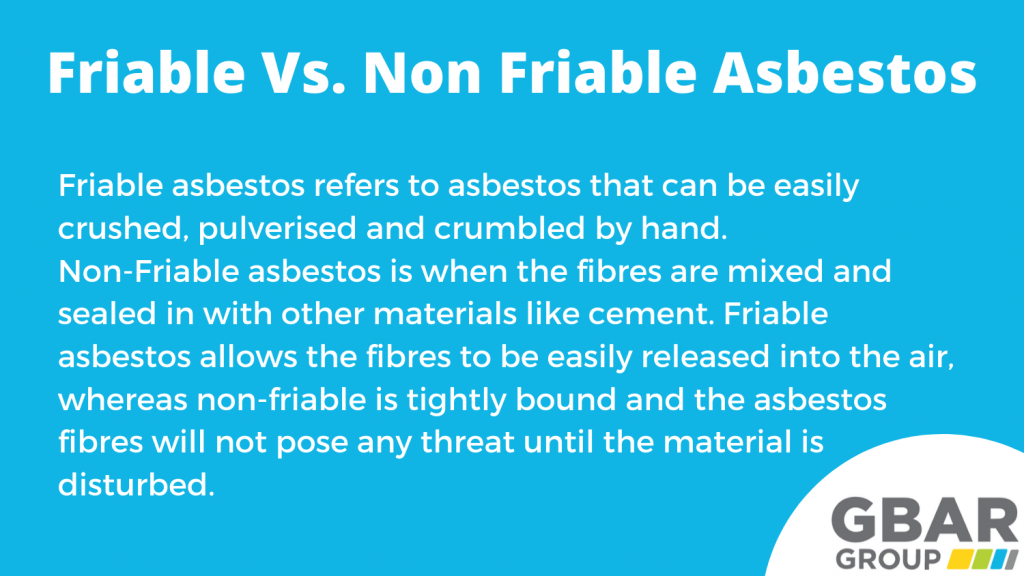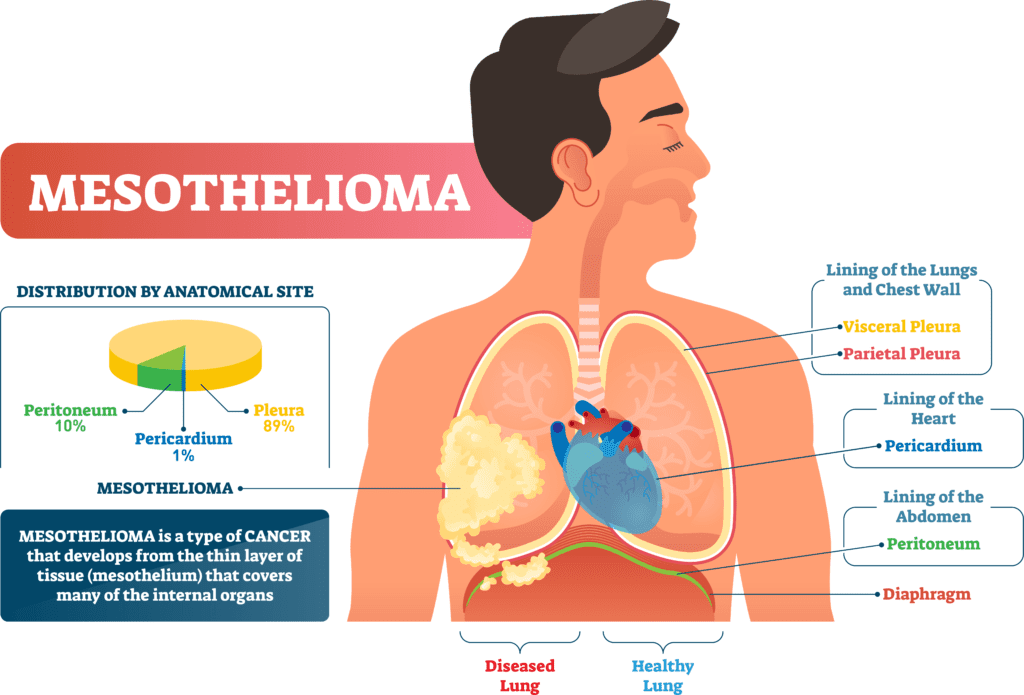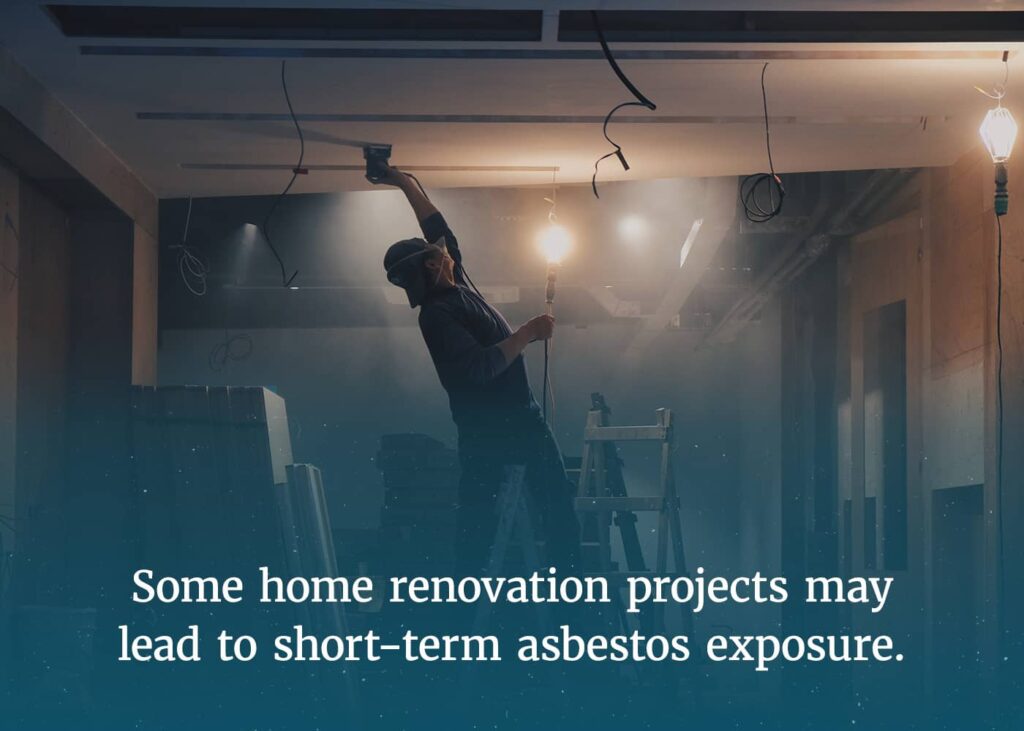If you’re a smoker, you may be wondering about the potential exposure to asbestos. With the health risks already associated with smoking, adding asbestos exposure to the mix sounds concerning. This article aims to shed light on the connection between smoking and asbestos, exploring whether smokers are significantly exposed to this harmful substance. By understanding the risks involved, you can make informed decisions about your health and well-being.
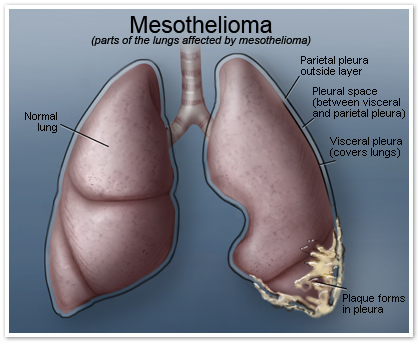

What is asbestos?
Definition and background
Asbestos is a naturally occurring mineral that is widely known for its heat resistance and strength. It has been used for centuries in various industries due to its versatile properties. Asbestos fibers are microscopic and can easily become airborne. When inhaled, these fibers can cause serious health issues, including respiratory diseases and cancer.
Types of asbestos
There are six types of asbestos, classified into two categories: serpentine asbestos and amphibole asbestos. Chrysotile, which falls under serpentine asbestos, is the most common type and accounts for about 95% of asbestos used worldwide. The amphibole category includes amosite, crocidolite, tremolite, anthophyllite, and actinolite. Each type has unique characteristics and poses specific health risks.
Common uses of asbestos
Asbestos has been widely used in numerous industries due to its fire resistance and durability. Common applications include insulation, roofing materials, floor tiles, cement, friction materials, and textiles. It was commonly used in houses and buildings constructed before the 1980s. However, due to the potential health risks associated with asbestos exposure, its usage has been regulated and limited in many countries.
The health risks of asbestos exposure
Respiratory diseases linked to asbestos
Long-term exposure to asbestos can lead to various respiratory diseases, some of which are life-threatening. Asbestosis is a chronic lung condition caused by the scarring of lung tissue due to asbestos fibers. Symptoms include persistent coughing, shortness of breath, chest pain, and a dry crackling sound while breathing. Pleural thickening and pleural effusion are other complications that can arise from asbestos exposure.
Cancer risks associated with asbestos
Asbestos is a known carcinogen and has been linked to several types of cancer. Mesothelioma, a rare and aggressive cancer, primarily affects the lining of the lungs, abdomen, or heart. Lung cancer, particularly in individuals who smoke, is another significant risk associated with asbestos exposure. Other cancers linked to asbestos include ovarian, laryngeal, and gastrointestinal cancers.
Dangers of long-term asbestos exposure
Long-term asbestos exposure significantly increases the risk of developing serious health conditions. Asbestos fibers can accumulate in the lungs and other organs over time, causing inflammation, scarring, and genetic damage. The latency period between exposure and the onset of diseases can range from several years to several decades. Therefore, even minimal exposure to asbestos can have severe consequences in the long run.
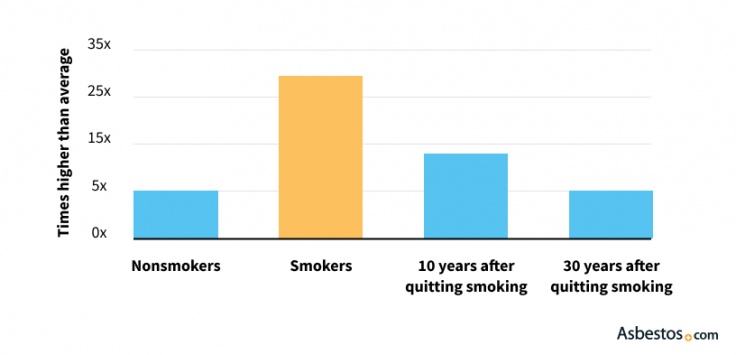

Smoking and asbestos exposure
How smoking affects asbestos-related diseases
Smoking is a known risk factor for various respiratory diseases, including lung cancer and chronic obstructive pulmonary disease (COPD). When combined with asbestos exposure, smoking exacerbates the harmful effects on the respiratory system. Smokers who have been exposed to asbestos are at a significantly higher risk of developing asbestos-related diseases compared to non-smokers.
Interaction between smoking and asbestos exposure
The interaction between smoking and asbestos exposure is complex. Studies have shown that smoking weakens the lungs’ natural defense mechanisms, making it easier for asbestos fibers to penetrate deeper into the respiratory system. Additionally, smoking causes chronic inflammation and damages the cilia, the tiny hair-like structures that help remove foreign particles from the lungs. This impaired lung function further increases the risk of asbestos-related diseases.
Increased risk of lung cancer
The combined effects of smoking and asbestos exposure greatly increase the risk of developing lung cancer. While asbestos exposure alone can increase the risk of lung cancer by up to 5 times, the risk is significantly higher for smokers exposed to asbestos. Synergistic interactions between tobacco smoke and asbestos fibers can cause genetic mutations and other cellular changes that pave the way for cancer development.
Occupational asbestos exposure
Industries at high risk of asbestos exposure
Numerous industries have historically had high levels of asbestos exposure, including construction, shipbuilding, mining, manufacturing, and automotive repair. Workers involved in insulation installation, demolition, and renovation are particularly susceptible to asbestos exposure. It is crucial for employees in these industries to follow proper safety protocols to minimize the risk of inhaling asbestos fibers.
Occupational safety regulations
Occupational safety regulations and guidelines have been put in place to protect workers from asbestos exposure. These regulations include requirements for personal protective equipment, proper ventilation systems, and regular monitoring of asbestos levels in the workplace. Employers have a legal obligation to provide a safe working environment and must adhere to these regulations to prevent asbestos-related diseases among their employees.
Asbestos-related diseases in workers who smoke
Workers who are exposed to asbestos and smoke cigarettes face a significantly higher risk of developing asbestos-related diseases. Smoking damages the lungs and weakens the respiratory system, making it more susceptible to the detrimental effects of asbestos fibers. If you work in an industry with potential asbestos exposure, it is crucial to prioritize both workplace safety measures and smoking cessation to reduce your risk.
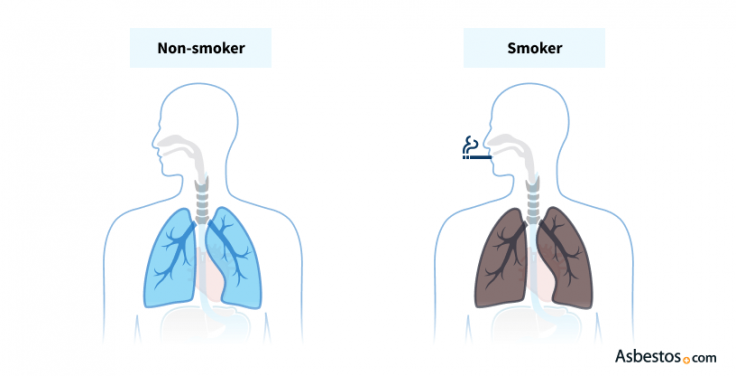

Secondhand exposure to asbestos
Risks of asbestos exposure for non-smokers
Secondhand exposure to asbestos can occur when individuals come into contact with asbestos fibers that have been brought home by workers in high-risk industries. Family members and close contacts of workers with asbestos exposure are at risk of inhaling these fibers, potentially leading to the same health issues associated with direct exposure. Non-smokers who experience secondhand asbestos exposure should be aware of the potential risks and seek medical advice if necessary.
Effects of secondhand smoke on asbestos-related diseases
Secondhand smoke has been shown to worsen the health consequences of asbestos exposure. The combination of secondhand smoke and asbestos fibers can have a synergistic effect, increasing the risk of developing respiratory diseases and lung cancer. Individuals who have been exposed to asbestos indirectly should take precautions to minimize any additional respiratory stress, such as avoiding environments with active smoking or improving indoor air quality.
Preventing asbestos exposure
Workplace safety measures
To prevent asbestos exposure in the workplace, employers must implement strict safety measures. This includes conducting asbestos surveys to identify potential sources of exposure, providing proper personal protective equipment, offering training on safe handling and removal of asbestos-containing materials, and ensuring proper ventilation and containment of asbestos fibers. Regular monitoring and maintenance of asbestos-containing materials are essential to prevent accidental release of fibers.
Safety precautions for smokers
If you are a smoker and work in an industry with potential asbestos exposure, it is crucial to take extra precautions. Quitting smoking is the most effective way to reduce your risk of developing asbestos-related diseases. Additionally, wearing appropriate personal protective equipment, such as respiratory masks, and following all workplace safety protocols can minimize your exposure to asbestos fibers.
Protecting non-smokers
To protect non-smokers from the potential health risks associated with secondhand asbestos exposure, it is important to create and maintain a smoke-free environment. This includes implementing workplace policies that prohibit smoking and educating workers on the risks of secondhand smoke. Ventilation systems should be in place to ensure clean air quality, and home decontamination measures should be taken if there is a risk of secondhand asbestos exposure.
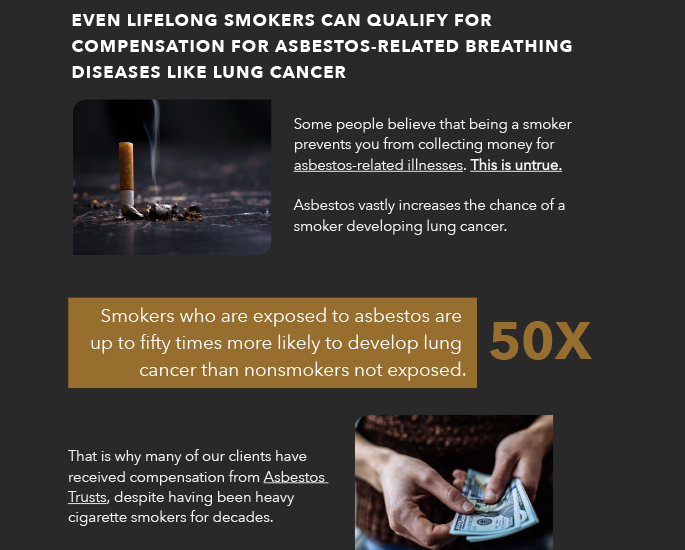

Detecting asbestos-related diseases
Early symptoms and diagnosis
Early detection plays a vital role in managing asbestos-related diseases. It is essential to recognize the early symptoms, which can include persistent cough, shortness of breath, chest pain, fatigue, and unexplained weight loss. If you have a history of asbestos exposure or suspect you may have been exposed, it is important to consult a healthcare professional who can conduct a thorough evaluation and order relevant diagnostic tests.
Medical tests for asbestos-related diseases
Medical tests used to diagnose asbestos-related diseases include imaging tests such as chest X-rays, CT scans, and PET scans. Pulmonary function tests assess lung capacity and breathing ability. Additionally, a biopsy may be necessary to confirm the presence of asbestos-related cancer. Regular health check-ups and screenings are recommended, especially for individuals with a known history of asbestos exposure.
Health monitoring for high-risk individuals
Individuals who have been exposed to asbestos, especially those who work in high-risk industries or who have a smoking history, should undergo regular health monitoring. This involves periodic medical evaluations, including lung function tests and imaging scans, to assess any changes in lung health. Regular monitoring allows for early detection and intervention, improving the chances of successful management and treatment.
Treatment options for asbestos-related diseases
Managing respiratory conditions
For individuals with respiratory conditions caused by asbestos exposure, various treatment options are available. Medications can help manage symptoms such as coughing and shortness of breath. Pulmonary rehabilitation programs may improve lung function and overall quality of life. In severe cases, oxygen therapy or lung transplantation may be necessary. Each patient’s treatment plan should be tailored to their specific needs and guided by healthcare professionals.
Cancer treatments for asbestos-related lung cancer
Asbestos-related lung cancer requires specialized treatment approaches. Treatment options may include surgery to remove tumors, radiation therapy to target cancer cells, and chemotherapy. Immunotherapy, a relatively new approach, is also being explored as a potential treatment for asbestos-related lung cancer. The choice of treatment depends on factors such as cancer stage, overall health, and patient preferences.
Supportive care for patients
Asbestos-related diseases can have a significant impact on an individual’s physical and emotional well-being. Alongside medical treatment, supportive care plays a crucial role in improving patients’ quality of life. Palliative care focuses on symptom management, pain relief, and providing emotional support. It is essential for patients and their loved ones to have access to a multidisciplinary healthcare team to address their physical, emotional, and practical needs.
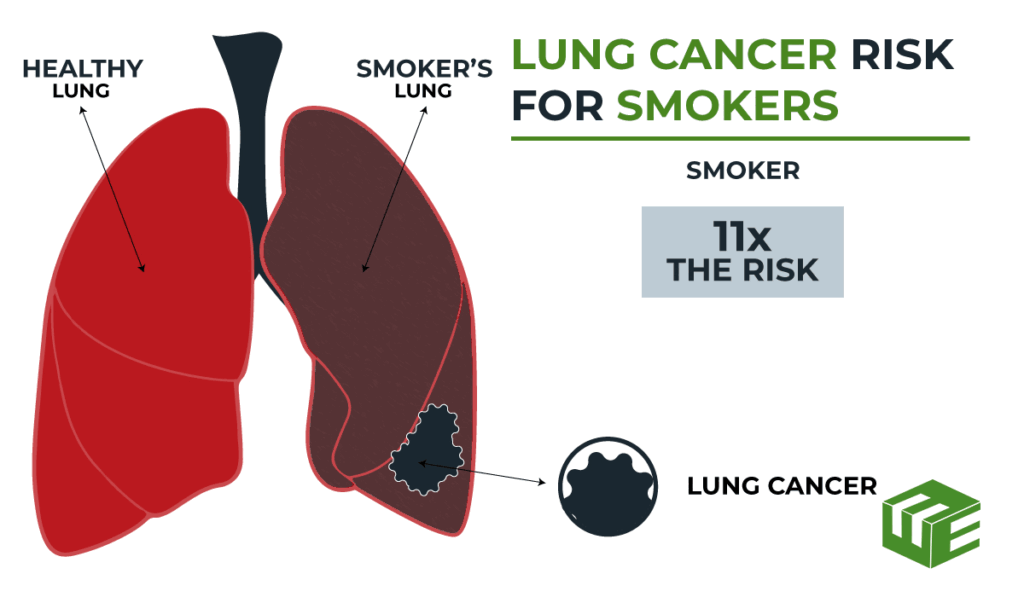

Legal aspects of asbestos exposure
Lawsuits and compensation
Asbestos-related diseases have led to numerous lawsuits seeking compensation for medical expenses, lost wages, and pain and suffering. Individuals who have been diagnosed with asbestos-related diseases due to occupational exposure may be eligible to pursue legal action against the responsible parties. Legal professionals specializing in asbestos litigation can provide guidance and support throughout the legal process.
Workers’ rights and compensation claims
Workers who have been exposed to asbestos and subsequently develop asbestos-related diseases are protected by workers’ rights and compensation laws. These regulations vary by jurisdiction but generally ensure that affected workers are entitled to medical benefits, disability compensation, and other financial support. It is essential for workers to be aware of their rights and options for compensation if they have suffered due to asbestos exposure.
Legislation regarding asbestos usage
In response to the health risks associated with asbestos exposure, many countries have implemented legislation to regulate or ban its usage. These laws aim to protect workers and the general public from potential harm. Additionally, regulations govern the handling, removal, and disposal of asbestos-containing materials to prevent accidental exposure. Strict enforcement of these laws is crucial to ensure public safety.
Conclusion
Summary of risks and precautions
Asbestos exposure poses significant health risks, including respiratory diseases and various types of cancer. Individuals who smoke and have been exposed to asbestos face an increased risk of developing life-threatening conditions such as lung cancer. Occupational asbestos exposure is particularly common in industries such as construction and manufacturing. Secondhand exposure to asbestos can also occur, putting non-smokers at risk. Prevention measures, including workplace safety protocols, smoking cessation, and creating smoke-free environments, are crucial for minimizing asbestos exposure.
Importance of awareness and prevention
Awareness of asbestos-related risks and prevention strategies is essential in protecting individuals from the harmful effects of exposure. It is crucial for both workers and employers to prioritize safety measures, comply with regulations, and take proactive steps to prevent unintentional exposure. Education and public awareness campaigns can play a significant role in promoting healthier environments and reducing the incidence of asbestos-related diseases.
Further research and education
Continued research is essential to gain a deeper understanding of the health risks associated with asbestos exposure and to explore more effective treatment options. Rigorous studies can help determine the effectiveness of preventive measures and provide valuable insights into the long-term consequences of asbestos exposure. Additionally, education programs should be developed to raise awareness among the general public, healthcare professionals, and individuals at high risk, promoting early detection, timely intervention, and improved outcomes.


